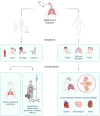Defining the pediatric response to SARS-CoV-2 variants
- PMID: 37304275
- PMCID: PMC10248061
- DOI: 10.3389/fimmu.2023.1200456
Defining the pediatric response to SARS-CoV-2 variants
Abstract
The global population has been severely affected by the coronavirus disease 2019 (COVID-19) pandemic, however, with older age identified as a risk factor, children have been underprioritized. This article discusses the factors contributing to the less severe response observed in children following infection with severe acute respiratory syndrome coronavirus 2 (SARS-CoV-2), including, differing viral entry receptor expression and immune responses. It also discusses how emerging and future variants could present a higher risk to children, including those with underlying comorbidities, in developing severe disease. Furthermore, this perspective discusses the differential inflammatory markers between critical and non-critical cases, as well as discussing the types of variants that may be more pathogenic to children. Importantly, this article highlights where more research is urgently required, in order to protect the most vulnerable of our children.
Keywords: COVID-19; SARS-CoV-2; age-specific response; cellular biology; children; emerging variants; molecular biology; pediatric.
Copyright © 2023 Ho, Bowen, Blyth, Imrie, Kollmann, Stick and Kicic.
Conflict of interest statement
The authors declare that the research was conducted in the absence of any commercial or financial relationships that could be construed as a potential conflict of interest.
Figures


References
-
- Viner RM, Mytton OT, Bonell C, Melendez-Torres GJ, Ward J, Hudson L, et al. . Susceptibility to SARS-CoV-2 infection among children and adolescents compared with adults: a systematic review and meta-analysis. JAMA Pediatr (2021) 175(2):143–56. doi: 10.1001/jamapediatrics.2020.4573 - DOI - PMC - PubMed
-
- Gaythorpe KAM, Bhatia S, Mangal T, Unwin HJT, Imai N, Cuomo-Dannenburg G, et al. . Children’s role in the COVID-19 pandemic: a systematic review of early surveillance data on susceptibility, severity, and transmissibility. Sci Rep (2021) 11(1):1–14. doi: 10.1038/s41598-021-92500-9 - DOI - PMC - PubMed
Publication types
MeSH terms
Substances
Supplementary concepts
LinkOut - more resources
Full Text Sources
Medical
Miscellaneous

